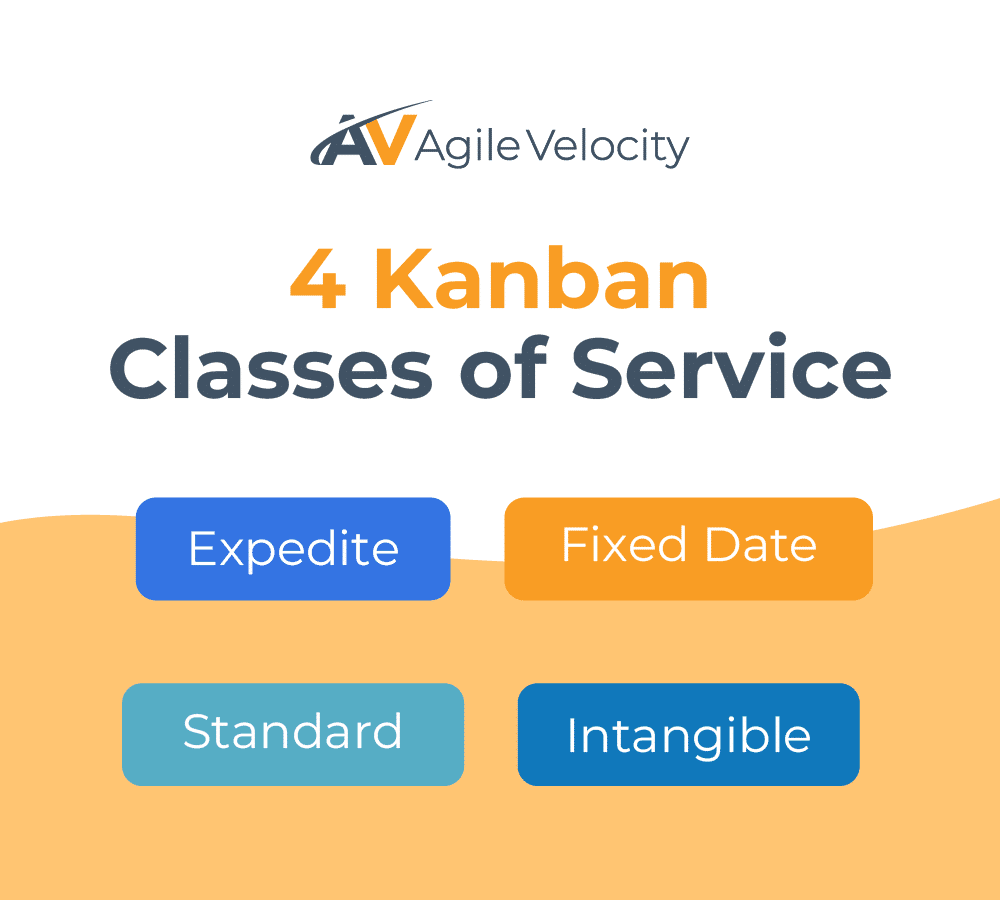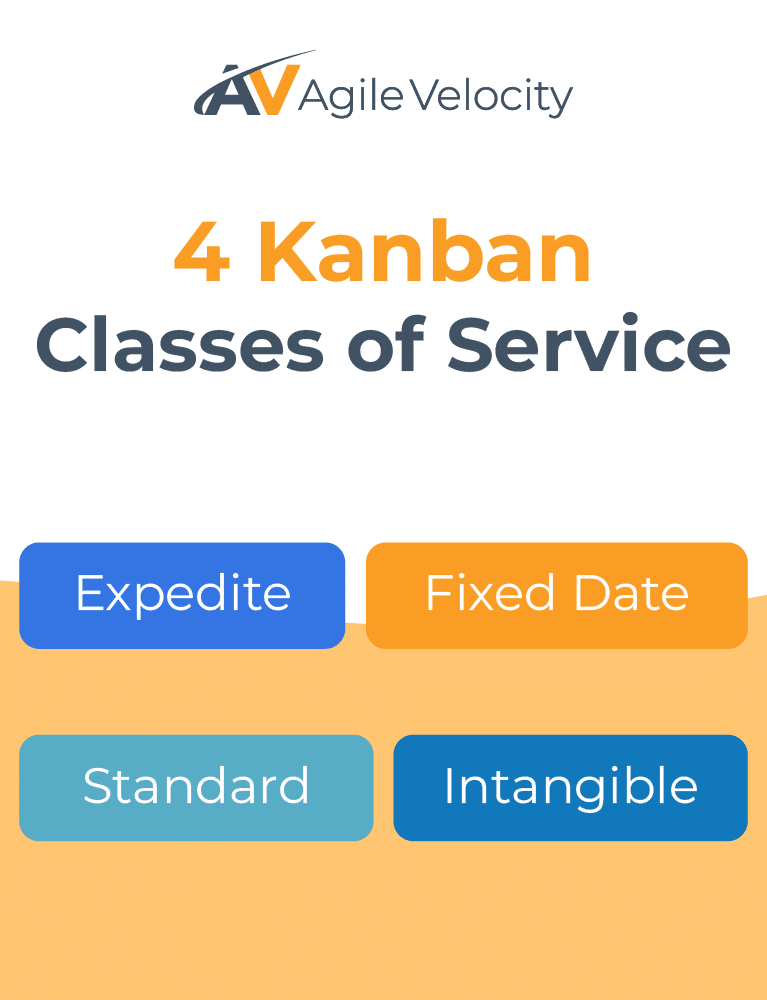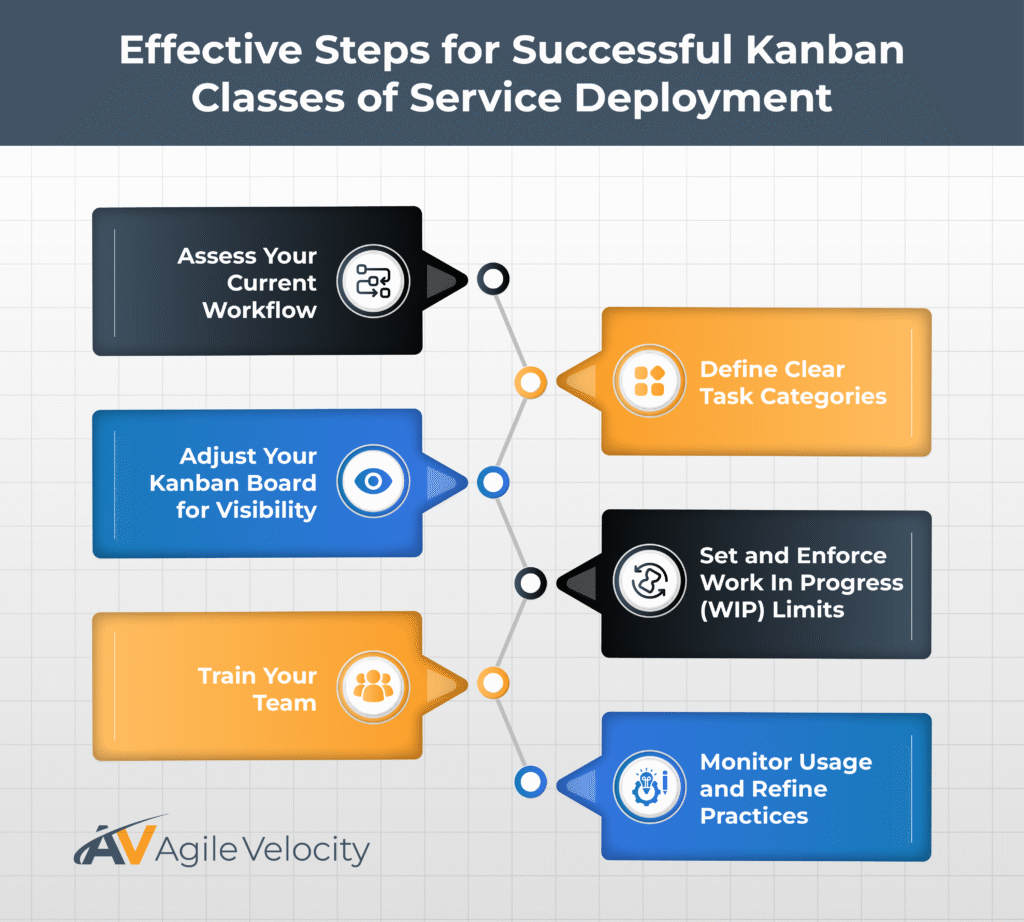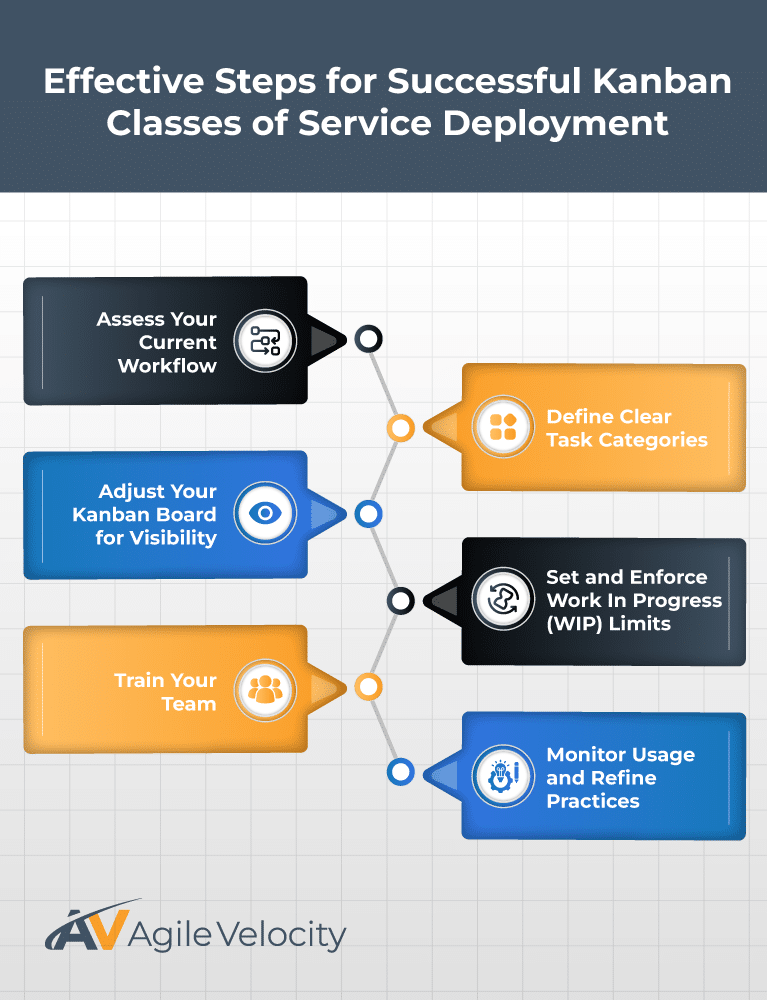Effectively organizing tasks can be a major challenge for teams, especially when faced with conflicting deadlines, unexpected interruptions, and multiple ongoing projects. Kanban Classes of Service offer a structured way to handle these challenges by helping teams categorize work based on urgency, business value, and deadlines. By clearly defining these categories, teams can streamline decision-making, enhance collaboration, and maintain a sharp focus on value delivery.
This approach encourages teams to prioritize tasks transparently, adapt to shifting demands, and align their efforts with organizational goals. In this article, we will explore the role of Kanban Classes of Service in optimizing task prioritization, illustrate how they align with Agile principles, and provide actionable steps for implementation. From creating clarity around urgent tasks to ensuring that longer-term objectives aren’t sidelined, Kanban Classes of Service can help teams strike a healthier balance and boost overall workflow efficiency.
What Are Kanban Classes of Service?
Kanban Classes of Service provide a practical method for task prioritization by categorizing work according to urgency, business value, and delivery timelines. These classes set clear expectations for teams, helping them determine which tasks require immediate action, which have binding deadlines, which follow routine processes, and which serve longer-term goals. By applying these categories consistently, teams can reduce confusion, limit unplanned disruptions, and significantly enhance progress.
When priorities are unclear, teams risk encountering bottlenecks, missed targets, and misaligned goals. Unplanned or urgent tasks might derail work already in progress, leaving important tasks delayed. Kanban Classes of Service remedy these issues by giving teams a shared, easy-to-understand structure for evaluating tasks, making each piece of work more predictable and purposeful.
Why Teams Struggle Without a Prioritization Framework
Without clear prioritization, teams can experience:
- Overburdened team members juggling too many tasks.
- Frequent task-switching that reduces productivity.
- Lack of clarity between tasks that demand urgent attention and those that do not.
- Confusion caused by no established criteria for task importance.
By introducing Kanban Classes of Service, teams can address these pitfalls and bring order to task prioritization. The framework ensures that crucial tasks receive top attention while routine and long-range work continues at a sustainable pace.
Key Benefits of Kanban Classes of Service
Implementing Kanban Classes of Service offers several advantages:
- Clarity in Prioritization: Teams gain immediate clarity on which tasks deserve urgent focus, which have fixed deadlines, and which drive strategic goals.
- Efficient Workflows: Categorized tasks help optimize resource allocation and reduce delays caused by confusion or overcommitting, bolstering workflow efficiency.
- Improved Predictability: A consistent classification system helps teams set more accurate timelines, minimizing last-minute surprises.
- Alignment with Business Objectives: Thoughtful categorization ensures the team is always contributing to outcomes that truly matter for the organization.
Kanban Classes of Service help create a flexible, consistent approach to workload management. This structure balances urgent work with routine tasks, lending stability and direction to any team seeking continuous improvement.
Foundational Kanban Concepts
To get the most out of Kanban Classes of Service, it helps to understand some of the core concepts that guide how tasks move and evolve in a Kanban system. These building blocks ensure that classes of service naturally fit into your existing processes.
What Is a Kanban Board?
A Kanban Board is a visual tool that reveals where tasks stand in the workflow. Common columns include “To Do,” “In Progress,” and “Done,” though teams often add columns like “Review” or “Testing” for clarity. Each task is represented as a card, which moves across the board as work is completed. This instant visibility reduces guesswork, highlights bottlenecks, and promotes better teamwork.
Understanding Work In Progress (WIP) Limits
Work In Progress (WIP) limits how many tasks can be active in a particular stage at any given time. They encourage a “finish what you start” mindset, limiting overload and preventing the chaos of juggling too many tasks at once. For example, if the WIP Limit in “In Progress” is three, the team must move one task forward before pulling another in.
What Are Commitment Points?
Commitment Points define the moment a task officially becomes the team’s responsibility. This threshold prevents teams from accepting more work than they can realistically handle. Once tasks pass this point, they’re part of the planned workload. It’s an inherently Agile concept that balances openness to new tasks with a need for reasonable load management.
Overview of the Four Kanban Classes of Service
Kanban Classes of Service offer a structured roadmap for task prioritization. The four primary categories—Expedite, Fixed Delivery Date, Standard, and Intangible—help teams choose a suitable management approach for each type of work.
Expedite Class: Drop Everything and Respond
The Expedite Class is meant for truly urgent tasks that demand immediate focus. These typically arise from emergency situations, such as severe bugs, production issues, or urgent customer escalations. Expedite work bypasses normal constraints so the team can address it right away. This class is used sparingly and typically reserved for work with high cost-of-delay risk or immediate impact.
However, labeling too many tasks as Expedite can spread resources thin. For a smoother flow, set clear criteria for what qualifies, and use the Expedite classification sparingly.
Fixed Delivery Date Class: Deadlines That Drive Planning
Tasks with firm, non-negotiable deadlines—like planned product launches or regulatory obligations—belong to the Fixed Delivery Date class. The team marks these timelines on the board, ensuring careful resource allocation to complete tasks on schedule.
It’s helpful to work backward from these deadlines. By identifying essential steps and milestones in advance, teams avoid last-minute overwhelm and protect time for other important work.
Standard Class: Building Workflow Consistency
Most tasks fall into the Standard class. These are routine pieces of work with no rigid deadline but that need to proceed at a regular pace. Examples might include feature enhancements, standard bug fixes, or maintenance tasks.
Since Standard work typically follows an established process, it benefits from steady WIP Limits, a well-organized board, and consistent collaboration. It’s the core flow of everyday work within Kanban.
Intangible Class: Long-Term, Low-Urgency Initiatives
The Intangible class captures tasks that don’t have immediate deadlines yet yield strategic or preventive benefits in the long run. This could include technical debt cleanup, research, or improvements to internal tools.
Even though these tasks seem less urgent, dedicating some capacity to them is vital. Neglecting Intangible work can lead to bigger headaches in the future.
Practical Benefits of Kanban Classes of Service
Implementing Kanban Classes of Service empowers teams to make smarter decisions around task management and prioritization, significantly enhancing workflow dynamics. By categorizing tasks clearly, teams can swiftly identify which projects require immediate attention and which can follow established schedules, minimizing miscommunications and aligning efforts with overarching business goals. This structured approach also mitigates the risk of overlooking long-term initiatives, promoting sustained organizational growth and resilience.
- Clear Priority Allocation – Categorizing work clarifies which tasks need to be executed first and those that can move forward in a predictable manner.
- Enhanced Workflow Efficiency – Defining tasks by class removes guesswork, helping teams allocate resources effectively and avoid bottlenecks.
- Reduced Interruptions and Multitasking – The process separates genuinely urgent tasks from routine ones, limiting the disruptions caused by constant reprioritization.
- Better Stakeholder Communication – Transparent classifications offer stakeholders a quick explanation for why certain tasks jump the line while others follow a standard flow.
- Improved Predictability – Teams can forecast timelines more accurately, resulting in informed commitments and steadier progress.
- Alignment with Agile Values – The clear structure reflects transparency, adaptability, and continuous improvement at every turn, keeping emphasis on delivering real value.
Overall, adopting this framework is a strategic move towards driving efficiency, predictability, and balance in team operations.
Steps to Successfully Implement Kanban Classes of Service
Successfully implementing Kanban Classes of Service involves understanding the unique challenges of your team and tailoring the system accordingly. It begins with educating team members on the purpose and benefits of each class, ensuring alignment on how to categorize and prioritize tasks. Establishing clear guidelines and criteria for classification is crucial, minimizing ambiguity in task management. Continuous feedback and refinement allow teams to adapt the system to evolving project demands, ensuring long-term alignment with organizational goals.
While every organization is different, most teams can adopt these steps to integrate Kanban Classes of Service:
1. Assess Your Current Workflow
Look at your existing processes, noting any recurring bottlenecks or patterns in how urgent tasks disrupt steady work.
2. Define Clear Task Categories
Define precise criteria for Expedite, Fixed Delivery Date, Standard, and Intangible so everyone understands how to classify tasks.
3. Adjust Your Kanban Board for Visibility
Customize your Kanban Board with labels or color-coding that highlight different classes of service. Make it obvious which tasks fall into each category.
4. Set and Enforce Work In Progress (WIP) Limits
Ensure your team finishes actively assigned tasks before taking on more. This protects your flow and maintains balance.
5. Train Your Team
Provide training sessions so each team member learns how and why to apply the classes consistently. Offer hands-on examples to close any knowledge gaps.
6. Monitor Usage and Refine Practices
Embrace continuous improvement by checking how tasks are classified over time and making adjustments as needed.
When effectively implemented, these steps ensure that Kanban Classes of Service drive more structured and accurate task prioritization. This fosters an environment where teams can work more collaboratively and proactively address potential challenges before they escalate. Ultimately, this method not only boosts productivity but also fosters a culture of accountability and strategic focus, enabling teams to consistently meet organizational objectives.
Best Practices for Using Kanban Classes of Service
Utilizing Kanban Classes of Service effectively requires a strategic approach that aligns with team goals and operational workflows. The key lies in implementing clear, consistent processes and actively engaging the team to keep everyone informed and on track.
Here are some best practices to consider when adopting Kanban Classes of Service:
- Use Simple, Clear Definitions: Ensure each Kanban class has straightforward descriptions to prevent misunderstandings and to promote consistent task categorization across the team.
- Frequently Review Tasks: Regularly reassess tasks to maintain accurate prioritization. This helps manage workload effectively and respond swiftly to changes in project demands.
- Track Metrics Like Lead and Cycle Time: Monitoring these metrics provides insights into the team’s performance and helps identify areas needing improvement, ensuring more predictable outcomes.
- Rely on Commitment Points: The point at which a team commits to delivering a task within the system – though work may not begin immediately, it enters the queue of deliverable items.
- Encourage Team Collaboration: Promote open dialogue and cooperation so that all team members understand how the system operates, contributing to a cohesive and efficient team dynamic.
- Reserve Bandwidth for Intangible Tasks: Allocating resources for long-term, strategic initiatives ensures that the team addresses technical debt and pursues continuous improvement, safeguarding future success.
By integrating these best practices, teams can leverage Kanban Classes of Service to create a well-structured and adaptable work environment. This not only enhances task prioritization and minimizes disruptions but also supports a culture of collaboration and continuous enhancement. Maintaining a balance between urgent demands and strategic initiatives positions teams to consistently achieve higher productivity and alignment with overarching business objectives.
Kanban Classes of Service in Action – An Example
Consider the hypothetical example of a technology team that manages both client-facing projects and internal improvements. The team often encounters sudden customer requests alongside planned monthly releases. By assigning urgent customer requests to the Expedite class, they can quickly identify high-impact tasks and reallocate resources when necessary. Meanwhile, tasks tied to established launch dates fall under Fixed Delivery Date, ensuring deadlines for new features stay visible on the board.
Routine bug fixes follow a Standard process, allowing the team to maintain quality without scrambling. Finally, internal upgrades that don’t cause immediate disruptions are categorized as Intangible, so they still receive attention but don’t overshadow higher-priority needs. This balanced approach ensures the team meets immediate obligations while also protecting capacity for meaningful improvements over time.
How Kanban Classes of Service Align with Agile Principles

Kanban Classes of Service provide teams with a flexible structure to manage workload while staying aligned with Agile values. By offering a clear framework for task prioritization, Kanban enhances transparency, adaptability, and the focus on continuous improvement. Each class of service allows teams to allocate resources effectively, ensuring that the most impactful tasks are prioritized. This alignment with Agile principles helps teams to navigate challenges tactically and maintain a focus on delivering true business value.
- Transparency: Kanban’s visible framework makes bottlenecks and priorities clear, ensuring that everyone understands the workflow and task status at any given moment.
- Adaptability: This system supports seamless transitions between shifting priorities without disrupting the overall workflow, allowing teams to remain agile in the face of change.
- Continuous Improvement: Regular review cycles and feedback loops inherent in the system foster refinement and enhance operational efficiency over time.
- Focus on Delivering Value: By spotlighting the tasks that provide the greatest impact, teams ensure that their efforts are consistently aligned with organizational goals.
Employing Kanban Classes of Service helps teams create a structured, yet adaptable work environment that mirrors Agile principles. By providing a clear visual representation of priorities, Kanban facilitates informed decision-making and fosters a culture centered on value-driven outcomes. This approach not only streamlines workflow management but also ensures a continuous alignment with the overarching objectives and values of Agile.
Importance of Kanban Training for Effective Task Management
Utilizing Kanban Classes of Service effectively requires a solid understanding of Kanban principles and the nuances of each class. Comprehensive Kanban training is essential for teams to ensure that they can fully leverage the system for enhanced task prioritization and workflow efficiency.
How Agile Velocity Drives Mastery in Kanban
- Tailored Learning Experience: Agile Velocity offers private Kanban training that addresses the specific needs of your organization, making learning applicable and impactful.
- Expert Trainers: The training is facilitated by seasoned Agile professionals who bring real-world experience, ensuring that teams can grasp both theoretical and practical applications of Kanban.
- Interactive Sessions: Engaging, hands-on sessions equip teams with the skills needed to confidently categorize and prioritize tasks, using methodologies that align with Agile best practices.
- Continuous Support: Beyond training, Agile Velocity provides ongoing support to help teams implement what they’ve learned, ensuring a smooth transition and sustained workflow improvements.
Agile Velocity’s comprehensive Kanban training ensures that your team is well-equipped to optimize workflow management. By mastering Kanban Classes of Service through structured guidance, teams can drive efficiency and align with organizational goals, paving the way for sustained success.
How Path to Agility® Navigator Helps Teams Map Out Success
Organizations often struggle to see the full picture when making the leap from old processes to an Agile way of working. Many teams want to know which specific changes will accelerate their Agile Transformation, how to track progress over time, and which next steps will yield the largest improvements. Path to Agility® Navigator is designed to fill those exact needs.
By visualizing all current processes in one centralized view, Path to Agility Navigator helps teams spot gaps in capabilities and chart a path forward. It enables leaders and team members to build a shared understanding of what must evolve—whether it’s improving how tasks move through Kanban Classes of Service or adjusting WIP Limits to reduce stress. Progress indicators make it straightforward to see where improvements are gaining momentum and where further work might be needed.
This tool also lets teams capture and prioritize their biggest opportunities for growth. Because of its built-in adaptability, teams can fine-tune objectives in real time without losing sight of overarching goals. By guiding each step with tangible data—such as cycle times and task throughput—Path to Agility Navigator encourages fact-based decisions rather than guesswork. The software provides clarity on potential dependencies, ensuring teams can coordinate effectively across different parts of the organization.
Ultimately, Path to Agility Navigator supports continuous improvement, showing teams how incremental steps build momentum for larger transformations. By turning broad objectives into practical next steps, it aligns seamlessly with Kanban Classes of Service, making it easier to keep urgent tasks on track while also driving long-term gains. It’s about helping teams embody Agile values every day, so they can deliver consistent value and maintain a forward-looking mindset.
Driving Sustainable Success with Kanban Excellence
Kanban Classes of Service offer a comprehensive approach to handle urgent tasks, honor key deadlines, and maintain steady progress on routine work—without neglecting long-term goals. Paired with foundational Kanban elements like WIP Limits and Commitment Points, these classes boost transparency, sustain focus, and foster collaboration.
Ready to take your task management and prioritization to the next level? Agile Velocity is here to help. With our expertise in Kanban, Agile Methodologies, and Path to Agility Navigator, we can empower your organization to navigate complexity, refine workflows, and drive sustainable success.







